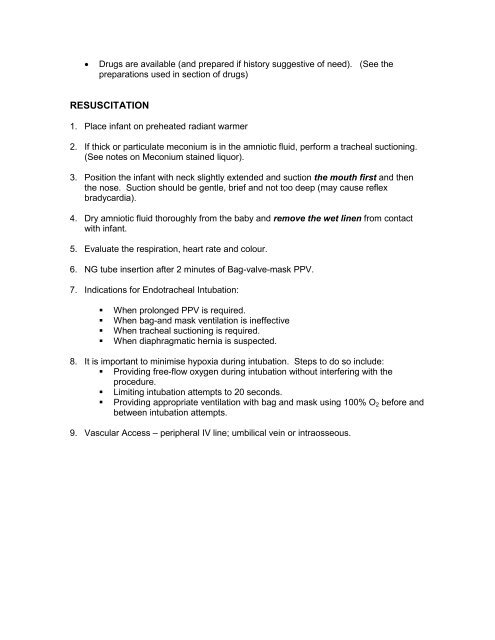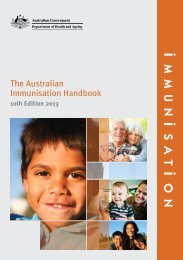Contents Chapter Topic Page Neonatology Respiratory Cardiology
Contents Chapter Topic Page Neonatology Respiratory Cardiology
Contents Chapter Topic Page Neonatology Respiratory Cardiology
Create successful ePaper yourself
Turn your PDF publications into a flip-book with our unique Google optimized e-Paper software.
• Drugs are available (and prepared if history suggestive of need). (See the<br />
preparations used in section of drugs)<br />
RESUSCITATION<br />
1. Place infant on preheated radiant warmer<br />
2. If thick or particulate meconium is in the amniotic fluid, perform a tracheal suctioning.<br />
(See notes on Meconium stained liquor).<br />
3. Position the infant with neck slightly extended and suction the mouth first and then<br />
the nose. Suction should be gentle, brief and not too deep (may cause reflex<br />
bradycardia).<br />
4. Dry amniotic fluid thoroughly from the baby and remove the wet linen from contact<br />
with infant.<br />
5. Evaluate the respiration, heart rate and colour.<br />
6. NG tube insertion after 2 minutes of Bag-valve-mask PPV.<br />
7. Indications for Endotracheal Intubation:<br />
When prolonged PPV is required.<br />
When bag-and mask ventilation is ineffective<br />
When tracheal suctioning is required.<br />
When diaphragmatic hernia is suspected.<br />
8. It is important to minimise hypoxia during intubation. Steps to do so include:<br />
Providing free-flow oxygen during intubation without interfering with the<br />
procedure.<br />
Limiting intubation attempts to 20 seconds.<br />
Providing appropriate ventilation with bag and mask using 100% O2 before and<br />
between intubation attempts.<br />
9. Vascular Access – peripheral IV line; umbilical vein or intraosseous.
















